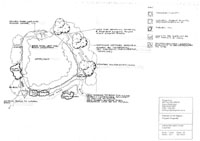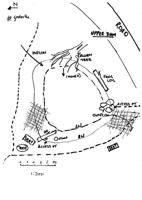All work around the dams will be done with minimal disturbance to the surrounding area and according to the following priorities:
- Control erosion
- Improve wildlife habitat.
- Improve public access.
- Blend with the surrounds.
ACT Parks & Conservation will place large boulders and logs in and around the dams. These provide excellent habitat as well as access points for people to approach the water’s edge. Some will be submerged, only becoming exposed when the water recedes during dry periods.
Seats will be made of simple cut logs and positioned to offer a good view of the dams and surrounds. With parental supervision in mind, they will be located close to access points and where paths draw near the water.
Coir erosion matting will be laid on eroded, compacted and high traffic areas around the dams including the main inflows and outflows. The matting reduces water erosion, traps organic matter and allows seeds to germinate and get a foothold. We expect to lay 600 to 800 square metres. Plants can be planted through the matting, which also helps to hold it in place. It will degrade completely in 2 or 3 years depending on conditions.
The planted area around the dams will be fenced off while young plants are becoming established. We expect this to take around 12 to 18 months. Where possible, the fences will run inside the walking tracks that pass the dams. This may not be possible in highly eroded areas where the tracks will be closed for time. An area of the lower dam will remain unfenced to allow direct access to the water for wildlife, although the fences are unlikely to restrict the kangaroos.
Due to recent rain, the water level is very high. Parks & Conservation will siphon the dams to a median level and allow works and planting to before the weather becomes too hot.
Concept plans: the following images are some of our design ideas.
 |





